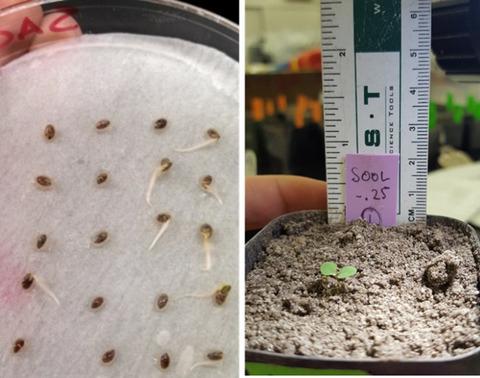当前位置:
X-MOL 学术
›
Funct. Ecol.
›
论文详情
Our official English website, www.x-mol.net, welcomes your feedback! (Note: you will need to create a separate account there.)
Ecological strategies begin at germination: Traits, plasticity and survival in the first 4 days of plant life
Functional Ecology ( IF 5.2 ) Pub Date : 2020-03-02 , DOI: 10.1111/1365-2435.13543 Julie E. Larson 1 , Brian L. Anacker 2, 3 , Sara Wanous 1 , Jennifer L. Funk 1
中文翻译:

生态策略始于发芽:植物生命的前4天的性状,可塑性和存活
更新日期:2020-03-02
Functional Ecology ( IF 5.2 ) Pub Date : 2020-03-02 , DOI: 10.1111/1365-2435.13543 Julie E. Larson 1 , Brian L. Anacker 2, 3 , Sara Wanous 1 , Jennifer L. Funk 1
Affiliation

|
- We commonly use trait variation to characterize plant function within and among species and understand how vegetation responds to the environment. Seedling emergence is an especially vulnerable window affecting population and community dynamics, yet trait‐based frameworks often bypass this earliest stage of plant life. Here we assess whether traits vary in ecologically meaningful ways when seedlings are just days old. How do shared evolutionary history and environmental conditions shape trait expression, and can traits explain which seedlings endure drought?
- We measured seedling traits in the first 4 days of life for 16 annual plant species under two water treatments, exploring trait trade‐offs, species‐level plasticity and the ability of traits to predict duration of survival under drought.
- Nearly half of traits showed the imprint of evolutionary history (i.e. significant phylogenetic signal), often reflecting differences between grasses and forbs, two groups separated by a deep evolutionary split. Water availability altered trait expression in most cases, though species‐level plastic responses also reflected evolutionary history.
- On average, new seedlings exhibited substantial trait variation structured as multiple trade‐offs like those found in mature plants. Some species invested in thick roots and shoots, whereas others invested in more efficient tissues. Separately, some invested in tougher roots and others in deeper roots. We also observed trade‐offs related to growth rates (fast or slow) and biomass allocation (above‐ or below‐ground). Drought survival time was correlated most strongly with seed mass, root construction and allocation traits, and phylogeny (grasses vs. forbs).
- Synthesis. Our results show that seed and seedling trait variation among annual species is substantial, and that a few attributes could capture major dimensions of ecological strategies during emergence. With seedling survival times ranging twofold among annuals (from 7.5 to 14.5 days), these strategies could mitigate recruitment responses to more frequent or longer dry spells. Multivariate trait and plasticity strategies should be further explored in studies designed to assess trait‐fitness linkages during recruitment.
中文翻译:

生态策略始于发芽:植物生命的前4天的性状,可塑性和存活
- 我们通常使用性状变异来表征物种内部和物种之间的植物功能,并了解植被如何对环境做出反应。幼苗出苗是影响人口和社区动态的特别脆弱的窗口,但是基于特征的框架通常绕过了植物生命的这一最早阶段。在这里,我们评估了当幼苗只有几日大时,性状是否以生态上有意义的方式发生变化。共同的进化史和环境条件如何影响性状表达,性状可以解释哪些幼苗耐旱?
- 我们在两种水处理下测量了16种一年生植物物种在生命的前4天的幼苗性状,探讨了性状权衡,物种水平可塑性和性状预测干旱持续时间的能力。
- 近一半的性状表现出进化史的印记(即重要的系统发生信号),通常反映出草与前缘草之间的差异,这两组被深深的进化分裂所分隔。在大多数情况下,水的可利用性改变了性状的表达,尽管物种水平的塑性反应也反映了进化史。
- 平均而言,新幼苗表现出显着的性状变异,结构类似于成熟植物中发现的多种权衡。一些物种投资于粗壮的根和芽,而另一些物种投资于更有效的组织。另外,有些投资于更坚强的根源,而另一些则投资于更深的根源。我们还观察到了与增长率(快或慢)和生物量分配(地上或地下)相关的权衡。干旱生存时间与种子质量,根系构造和分配性状以及系统发育(草与胚芽)密切相关。
- 合成。我们的结果表明,一年生物种之间的种子和幼苗性状变异很大,而且一些属性可以反映出萌芽期间生态策略的主要方面。在一年中,幼苗的存活时间是两倍(从7.5天到14.5天),这些策略可以减轻对更频繁或更长时间干旱的募集响应。在旨在评估招募期间特质与适应性联系的研究中,应进一步探索多元特质和可塑性策略。


























 京公网安备 11010802027423号
京公网安备 11010802027423号